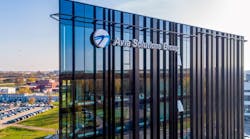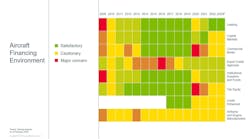This year AMT magazine celebrates 25 years of publication so we’re reflecting on the past and acknowledging entities that withstood the test of time and excelled. There are certain people, events, innovations, and companies that become icons in their category. Some examples for me are Snap-on ratchets, Boeing 747s, and Gulfstream business aircraft. When reviewing Gulfstream’s chronology, the challenge is deciding what to mention: which award-winning, record-setting aircraft models to highlight or which manufacturing enhancement to discuss. Innovation and expansion have definitely driven Gulfstream’s exceptional success during the last 25 years.
In the beginning
Gulfstream Aerospace Corp. stepped on the road to success in the late 1950s when Grumman Aircraft Engineering Co. developed the first aircraft specifically designed for business travel - the Gulfstream I (GI). It held 12 passengers, had a service ceiling of 25,000 feet, a range of 2,200 miles, and could fly 350 mph. Corporate pilots and executives loved this comfortable and reliable turbo prop. Its next strategic steps were moving civilian aircraft production to Savannah, GA, and building the jet-powered Gulfstream II (GII).
The last 25 years
We interviewed Barry Russell, vice president of Gulfstream Product Support’s East Coast Operations, to discuss some of the changes and innovations he has observed in his 30-plus years with Gulfstream. We pick up the last 25 years in 1989 when Allen Paulson teamed up with Forstmann, Little & Co. and bought Gulfstream back from Chrysler and the GIV, the first business jet with an all-glass cockpit, had been delivered.
The ‘90s
Gulfstream rolled out the GV, the first ultra-long range business jet, and opened the Savannah Service Center with 136,000 square feet of hangar space. In 1997 Gulfstream began the concurrent fabrication of the GIV-SP and the GV, a significant change to its manufacturing practice of linear production. The GV team was awarded the 1997 Robert J. Collier Trophy, the highest award in aeronautics or astronautics in North America, for improving the performance, efficiency, and safety of air or space vehicles.
2000 - 2014 new millennium growth and innovation
The growth in fleet types, manufacturing and service facilities, customer services offerings, and number of employees was exponential. General Dynamics purchased Gulfstream in 3Q1999 and in 2002 it renamed its fleet using Arabic numerals - the G550, G500, G400, G300, G200, G150 and G100. The Gulfstream G550 team won the Collier Trophy in 2003. “The G550 was the first civil aircraft to receive a Type Certificate issued by the Federal Aviation Administration (FAA) that includes an enhanced vision system (EVS) as standard equipment …” and “the first cockpit to incorporate PlaneView®, an integrated avionics suite featuring four 14-inch liquid crystal displays in landscape format and the first business-jet with in-flight, high-speed Internet connectivity.”
How Gulfstream’s technical work force has changed
Russell explains, “In the very early '90s the company’s headcount was 2,500 to 3,000. Now we have a work force of more than 14,000 employees worldwide, with about 9,000 located in Savannah. Product support is currently at more than 4,000 employees and our technicians have combinations of A&P certificates, FAA licenses, and EASA B1 and B2 certifications. They are computer and software literate, and some have or are pursuing a four-year degree. Each year Gulfstream invests heavily in training and tools because our technicians expect in-depth training on the model(s) that they are working on.”
Gulfstream instructors are embedded with partner FlightSafety International to deliver Total Technical Training (TTT) classes. Many Gulfstream technicians, and those who work for operators of Gulfstream aircraft, have earned FlightSafety’s Master Technician designation. These Master Technician certificates are proudly displayed along with other Gulfstream trophies and awards.
Growing the manufacturing capacity
There has been an explosion of new construction at Gulfstream, particularly at company headquarters in Savannah. Savannah’s footprint now covers more than 4 million square feet of hangars, shops, offices, service centers, paint hangars, a sales and design center, and research and development centers. The large-cabin G650, G550, G450 are manufactured in Savannah and outfitted in Savannah; Brunswick, GA; Long Beach, CA; or Appleton, WI. The super midsize G280 and mid-cabin G150 are co-manufactured in Tel Aviv at the Israel Aerospace Industries facility and outfitted in Dallas. An additional 110,000-square-foot maintenance repair and overhaul facility was recently announced for Brunswick.
The G650 - best in class business jet
Since 2008, business aircraft sales have been a bit soft so what is driving Gulfstream’s exponential growth? Simply put – demand for large-cabin aircraft and for the G650 in particular. Since entering service on Dec. 20, 2012, more than 50 G650s have been delivered and many more are on the way. Why the G650? According to Gulfstream, “[It] is the world standard in business aviation” and “flies faster, farther, and more comfortably than any other business aircraft in its class.” It has impressive numbers and incredible features to back up that claim. On Oct. 21, 2013 Gulfstream announced that the G650 had circled the globe westbound in 41 hours and seven minutes, establishing a world record in the C-1.l aircraft class; not surprising with a range of 7,000 nautical miles, maximum speed of Mach 0.925, and altitude of 51,000 feet. It has also set 39 city pair records.
Product support: people, planes, trucks and more
Gulfstream’s worldwide product support must be the envy of every major flight operation. Russell explains, “Our customer service begins with one call to our Technical Operations Center. We have professionals operating 11 global service centers and one component repair facility, all dedicated to world-class customer service. There are 13 authorized warranty centers and line service facilities in North and South America, Europe, Russia, India, Middle East, Africa, Asia, and Australia, and we stock about $1.4 billion in parts at strategic locations.”
Gulfstream Field and Airborne Support Teams (FAST) include two dedicated G150 aircraft, more than 30 dedicated pilots and technicians, and specially outfitted rapid-response trucks based across the United States and Europe. In January 2014 a specially equipped 74-foot tractor-trailer was added to provide support for owners and operators that attend major U.S. events, including the Super Bowl and Daytona 500.
When we asked Russell about significant changes in aircraft maintenance practices over the last 25 years, he replies, “Interactive 3-D technology for our new aircraft, the G650 and G280, assists our technicians by graphically displaying how a part is removed and installed. Technicians can easily view the graphics and the maintenance manual instructions, which helps reduce errors and the time it takes to troubleshoot systems.
"On the G450 and G550, we have PlaneConnect, a system that transmits maintenance data at top of descent to experts on the ground. The G650 takes that concept even further with a health and trend monitoring service, PlaneConnect HTM™.
"In our call center, we have an in-flight support center that includes graphical flight simulators for all Gulfstream models. Technical operations personnel can set up a simulator to mirror what is happening in flight. This often leads to much faster troubleshooting time for in-flight or operational issues."
I asked Russell what he saw taking place over the next 25 years. He wisely and professionally declined. He did make one suggestion for owners and operators. “Gulfstream aircraft are built to fly, so fly them as much as you can.”
Based on the rate of change in the last 25 years at Gulfstream, I would suggest that future AMTs will need to be familiar with 3-D or additive manufacturing, maintain supersonic business aircraft, and might even be using nanorobots to chase the gremlins out of the avionics bays.


